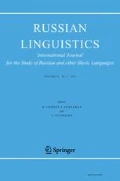Abstract
Russian verbs are considered to form aspectual pairs, perfective and imperfective. However, this system is complicated by the existence of so-called aspectual triplets, in which one perfective verb has two imperfective correlates (a primary imperfective and a secondary imperfective). This article offers new insights into the discussion of this controversial issue. While aspectual triplets have traditionally been treated as marginal, we present a systemic account of this phenomenon based on a corpus study of a comprehensive list of Russian aspectual triplets. In addition, contrary to some previous approaches, we propose unified semantics for the secondary imperfectives, namely, a telic process. We show that the meaning of a secondary imperfective is the result of interaction among the meaning of the prefix, the meaning of the verbal stem, and the general semantics of the secondary imperfective. We argue that the secondary imperfective is marginal if the semantics of the prefix or the semantics of the verbal stem are not compatible with the notion of result.
Аннотация
Традиционно считается, что глаголы в русском языке образуют видовые пары, состоящие из глагола совершенного вида и глагола несовершенного вида. Однако эта система усложняется существованием так называемых аспектуальных троек, в которых один глагол совершенного вида соотносится с двумя глаголами несовершенного вида. В этой статье мы предлагаем новый подход к этой проблеме. В то время как видовые тройки обычно рассматриваются как маргинальное явление, мы представляем системный подход к этим глаголам, основанный на корпусном исследовании представительного списка русских видовых троек. Кроме того, в отличие от некоторых прежних подходов, мы считаем, что вторичные имперфективы обладают единой семантикой, а именно, обозначают предельный процесс. Мы показываем, что каждый вторичный имперфектив складывается из значения приставки, значения глагольной основы и семантики предельного процесса, присущей вторичным имперфективам. Мы утверждаем, что вторичный имперфектив низкочастотен в тех случаях, когда семантика приставки или семантика глагольной основы не сочетаются со значением предельности.
Similar content being viewed by others
Notes
Complex act perfective—capfv; imperfective—ipfv; natural perfective—npfv; perfective—pfv; primary imperfective—ipfv1; secondary imperfective—ipfv2; single act perfective—sapfv; specialized perfective—spfv.
In this article we are primarily interested in the semantics and productivity of aspectual triplets. The issue of whether aspectual markers function as inflectional or derivational markers in Russian lies outside the scope of this article and is not discussed. For a thorough discussion of this problem, see Percov (1998, 2001, pp. 128–138).
Large groups of so-called ‘biaspectual verbs’ in Russian have the same form for both aspects (e.g., ispol’zovat’ ‘use’); however, in a sentence, each occurrence of such verbs is unequivocally either perfective or imperfective.
Small groups of verbs in Russian are simplex perfective verbs that form pairs with secondary imperfectives, i.e., dat’ – davat’ ‘give’. This group of verbs is not discussed in this paper because these verbs do not contribute to triplets.
In order to save space we have provided one gloss per triplet. The semantic difference between primary and secondary imperfectives is discussed in more detail in Sect. 3.1.
Angle brackets exemplify a context.
These verbs do not form a triplet according to our definition.
The database and information regarding data collection for this research are available at http://emptyprefixes.uit.no.
The high number of natural perfectives in the database is the result of prefix variation. Many verbs can use more than one prefix to form a natural perfective (e.g., mazat’ ‘smear’ has 6 npfvs: namazat’, zamazat’, pomazat’, izmazat’, vymazat’, promazat’). For more information about prefix variation in the EE database, see Janda and Lyashevskaya (2011).
The Google search was carried out in April and May 2010.
www.biznet.ru/topic76013.html (April 2010).
www.protiv-putina.ru/forum/index.php?showtopic=16&st=15 (April 2010).
A chi-square test shows that the probability that these distributions are due to chance is \(P = \mbox{1.496e-06}\) (chi-square = 16.73, \(\mathit{df} =1\)) for the prefix po-.
A chi-square test shows that the probability that these distributions are due to chance is \(P = \mbox{2.749e-07}\) (chi-square = 26.42, \(\mathit{df} =1\)) for vy-, and \(P = 0.014\) (chi-square = 6.0919, \(\mathit{df} =1\)) for raz-.
References
Apresjan, Ju. D. (1995). Traktovka izbytočnyx aspektual’nyx paradigm v tolkovom slovare. In Ju. D. Apresjan, Izbrannye trudy. Tom 2: Integral’noe opisanie jazyka i sistemnaja leksikografija (pp. 102–113). Moskva.
Bulygina, T. V., & Šmelev, A. D. (1997). Jazykovaja konceptualizacija mira (na materiale russkoj grammatiki). Moskva.
Bybee, J. L., & Dahl, Ö. (1989). The creation of tense and aspect systems in the languages of the world. Studies in Language, 13(1), 51–103.
Čertkova, M. Ju. (1996). Grammatičeskaja kategorija vida v sovremennom russkom jazyke. Moskva.
Cubberly, P. V. (1982). On the ‘empty’ prefixes in Russian. Russian Language Journal, 36, 14–30.
Dickey, S. M. (2012). Orphan prefixes and the grammaticalization of aspect in South Slavic. Jezikoslovlje, 13(1), 71–105.
Evgen’eva, A. P. (Ed.) (1999). Malyj akademičeskij slovar’. Moskva.
Glovinskaja, M. Ja. (2001). Mnogoznačnost’ i sinonimija v vido-vremennoj sisteme russkogo glagola. Moskva.
Isačenko, A. V. (1960). Grammatičeskij stroj russkogo jazyka v sopostavlenii s slovackim. Morfologija (Tom 2). Bratislava.
Janda, L. (2007). Aspectual clusters of Russian verbs. Studies in Language, 31(3), 607–648.
Janda, L. A., & Lyashevskaya, O. (2011). Prefix variation as a challenge to Russian aspectual pairs: are zavjaznut’ and uvjaznut’ ‘get stuck’ the same or different? Russian Linguistics, 35(2), 147–167.
Janda, L., et al. (2013). Why Russian aspectual prefixes aren’t empty. Prefixes as verb classifiers. Bloomington.
Jasai, L. (2001). O specifike vtoričnyx imperfektivov vidovyx korreljacij. In I. V. Nedjalkov (Ed.), Issledovanija po jazykoznaniju: K 70-letiju člena-korrespondenta RAN Aleksandra Vladimiroviča Bondarko (pp. 106–118). Sankt-Peterburg.
Kasevič, V. B. (1977). Elementy obščej lingvistiki. Moskva.
Kozera, I. (2015). Semantika i pragmatika vtoričnoj imperfektivacii russkogo glagola (na osnovanii rezul’tatov oprosa). Przegląd Rusycystyczny, 151(3), 56–72.
Kuznecov, P. S. (1953). Istoričeskaja grammatika russkogo jazyka. Moskva.
Ljaševskaja, O. N., & Šarov, S. A. (2009). Častotnyj slovar’ sovremennogo russkogo jazyka (na materialax Nacional’nogo Korpusa Russkogo Jazyka). Moskva.
Maslov, Ju. S. (1984). Vid i leksičeskoe značenie glagola v sovremennom russkom literaturnom jazyke. In Ju. S. Maslov, Očerki po aspektologii (pp. 48–65). Leningrad.
Maslov, Ju. S. (2004). Rol’ tak nazyvaemoj perfektivacii i imperfektivacii v processe vozniknovenija slavjanskogo glagol’nogo vida. In Ju. S. Maslov, Izbrannye trudy. Aspektologija. Obščee jazykoznanie (Sost. i red. A. V. Bondarko, T. A. Majsak, V. A. Plungjan; pp. 445–476). Moskva.
Ožegov, S. I., Švedova, N. Ju. (2001). Slovar’ russkogo jazyka. Moskva.
Percov, N. V. (1998). Russkij vid: slovoizmenenie ili slovoobrazovanie? In M. Ju. Čertkova (Ed.), Tipologija vida. Problemy, poiski, rešenija (pp. 343–355). Moskva.
Percov, N. V. (2001). Invarianty v russkom slovoizmenenii. Moskva.
Petruxina, E. V. (2000). Aspektual’nye kategorii glagola v russkom jazyke v sopostavlenii s češskim, slovackim, pol’skim i bolgarskim jazykami. Moskva.
Plungjan, V. A. (2011). Vvedenie v grammatičeskuju semantiku: grammatičeskie značenija i grammatičeskie sistemy jazykov mira. Moskva.
Ramchand, G. C. (2004). Time and the event: the semantics of Russian prefixes. In P. Svenonius (Ed.), Nordlyd. Tromsø Working Papers on Language and Linguistics, 32(2): Special issue on Slavic prefixes (pp. 323–361). Tromsø.
Šaxmatov, A. A. (1941). Očerk sovremennogo russkogo literaturnogo jazyka. Moskva.
Shead, S. L. (2011). Radical frame semantics and biblical Hebrew. Exploring lexical semantics (Biblical Interpretation Series, 108). Leiden, Boston.
Švedova, N. Ju. (1980). Russkaja grammatika (Vol. 1). Moskva.
Svenonius, P. (2004). Slavic prefixes inside and outside VP. In P. Svenonius (Ed.), Nordlyd. Tromsø Working Papers on Language and Linguistics, 32(2): Special issue on Slavic prefixes (pp. 205–253). Tromsø.
Timberlake, A. (2004). A reference grammar of Russian. Cambridge.
Veyrenc, J. (1980). Un problème de formes concurrentes dans l’économie de l’aspect verbal en russe: imperfectifs premiers et imperfectifs seconds. In J. Veyrenc, Études sur les verbe russe (pp. 159–179). Paris.
Xrakovskij, V. S. (2005). Aspektual’nye trojki i vidovye pary. Russkij jazyk v naučnom osvjaščenii, 9(1), 46–59.
Zaliznjak, A. A., & Mikaėljan, I. L. (2010). O meste vidovyx troek v aspektual’noj sisteme russkogo jazyka. In A. E. Kibrik (Ed.), Komp’juternaja lingvistika i intellektual’nye texnologii. Po materialam ežegodnoj Meždunarodnoj konferencii “Dialog”. Bekasovo, 26–30 maja 2010 g. (Vyp. 9(16), pp. 130–136). Moskva.
Zaliznjak, A. A., & Šmelev, A. D. (2000). Vvedenie v russkuju aspektologiju. Moskva.
Author information
Authors and Affiliations
Corresponding author
Additional information
We would like to thank all the members of the CLEAR Group at the University of Tromsø for their help and comments. This research was conducted within the ‘Exploring Emptiness’ project supported by the Norwegian Research Council. Versions of this paper were presented for the Cognitive Linguistics Reading Group at the University of Tromsø, at Saint-Petersburg State University in Russia, and at the Slavic Linguistic Society (SLS) Conference in Chicago in 2011. We are grateful to all the participants of these meetings for their comments and suggestions.
Rights and permissions
About this article
Cite this article
Kuznetsova, J., Sokolova, S. Aspectual triplets in Russian: semantic predictability and regularity. Russ Linguist 40, 215–230 (2016). https://doi.org/10.1007/s11185-016-9166-9
Published:
Issue Date:
DOI: https://doi.org/10.1007/s11185-016-9166-9




